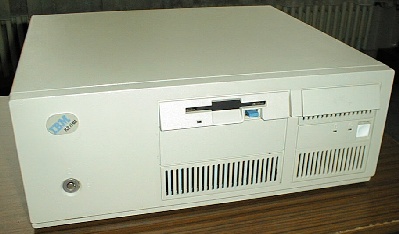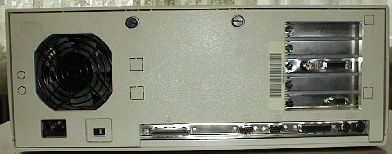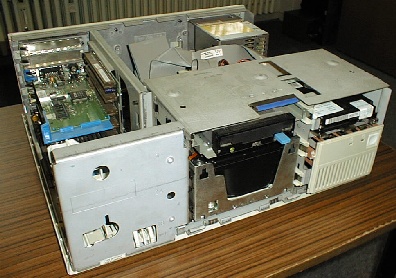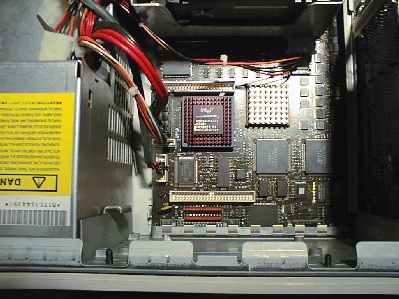
Click here or click onto the photo for a full size version of this picture.
Just like the Model 57 was just a Model 56 in a bigger box, the 77 is a Model 76 with more room for expansion. It has five expansion slots instead of three, and there are more drive bays. Of course, there are actually only four usable MCA slots since one of them is occupied by a graphics card; the 'Bermuda' planar used in the first generation of Model 76/77 doesn't have a video interface, so a video card is needed that includes a VGA for the text modes; accelerator cards like the IBM 8514/A or ATI Graphics Ultra that only add higher resolution graphics modes do not work! Typically, these models came with an IBM XGA(-2) adapter, but the 'simple' SVGA Adapter/A popular in the Model 85/95 works also if you have no need for fancy graphics. By the way, the blue IBM badge signals that the video adapter in this machine (an XGA-2) can display graphics at ergonomic refresh rates :-)

Click here or click onto the photo for
a full size version of this picture.
Looking at the back side, we gladly find that there are already two serial ports on-board, a sign of most newer PS/2 models with a 95xx type designation. The external SCSI port however uses the IBM-proprietary 60-pin Mini Centronics connector, which makes buying cables an expensive task...

Click here or click onto the photo for
a full size version of this picture.
The nice thing about the 77's case is that there is room for old, full-height SCSI drives. I added an old 300M Micropolis drive that almost doubles the weight of the whole machine :-)

Click here or click onto the photo for
a full size version of this picture.
A closer look onto the CPU section of the main board. Hidden below a silver cooling plate, there is the original 486SX processor that is turned off as soon as an upgrade processor is inserted into the other socket. Since it is soldered onto the board, you cannot remove it and it still consumes power for doing nothing - thankfully, this concept introduced by Intel with the 486SX was quickly dropped and replaced by 'multifunction' sockets that can cope with all types of 486 processors. There were also variants of the Bermuda planar with no 486SX soldered in and with a better CPU factory-installed in the upgrade socket.
The upgrade processor itself is also an interesing beast. Opposed to its labeling, it is running at 66 and not 33 MHz. Probably the labling means that this is an upgrade for 33 MHz systems, not an upgrade running at 33 MHz. If you want to add an upgrade to a Bermuda yourself, be sure to get an ODP and not an ODPR version - the additional 'R' means 'replace', i.e. remove the old processor, which is difficult in this case...
- Processor:
- Intel ODP486DX33 @ 66 MHz (upgrade),
Intel i486SX @ 33MHz (original) - Coprocessor:
- integrated into CPU
- Cache:
- 8K internally in CPU
- Memory:
- 16 Mbytes (options range from 4M to 32M)
- Bus:
- 5 MCA slots (32 bit)
- Interfaces (onboard):
-
- Mouse, Keyboard
- 2 x Serial
- 1 x Parallel
- Floppy (2.88M), allows attachment of up to 3(!) drives
- SCSI (narrow)
- Add-on cards:
-
- 3COM 3C529 Ethernet Adapter
- IBM XGA-2 Graphics Adapter
- Operating System(s):
-
- Caldera OpenDOS 7.01
- Linux 2.2 (Slackware-based)
- Useful Links: